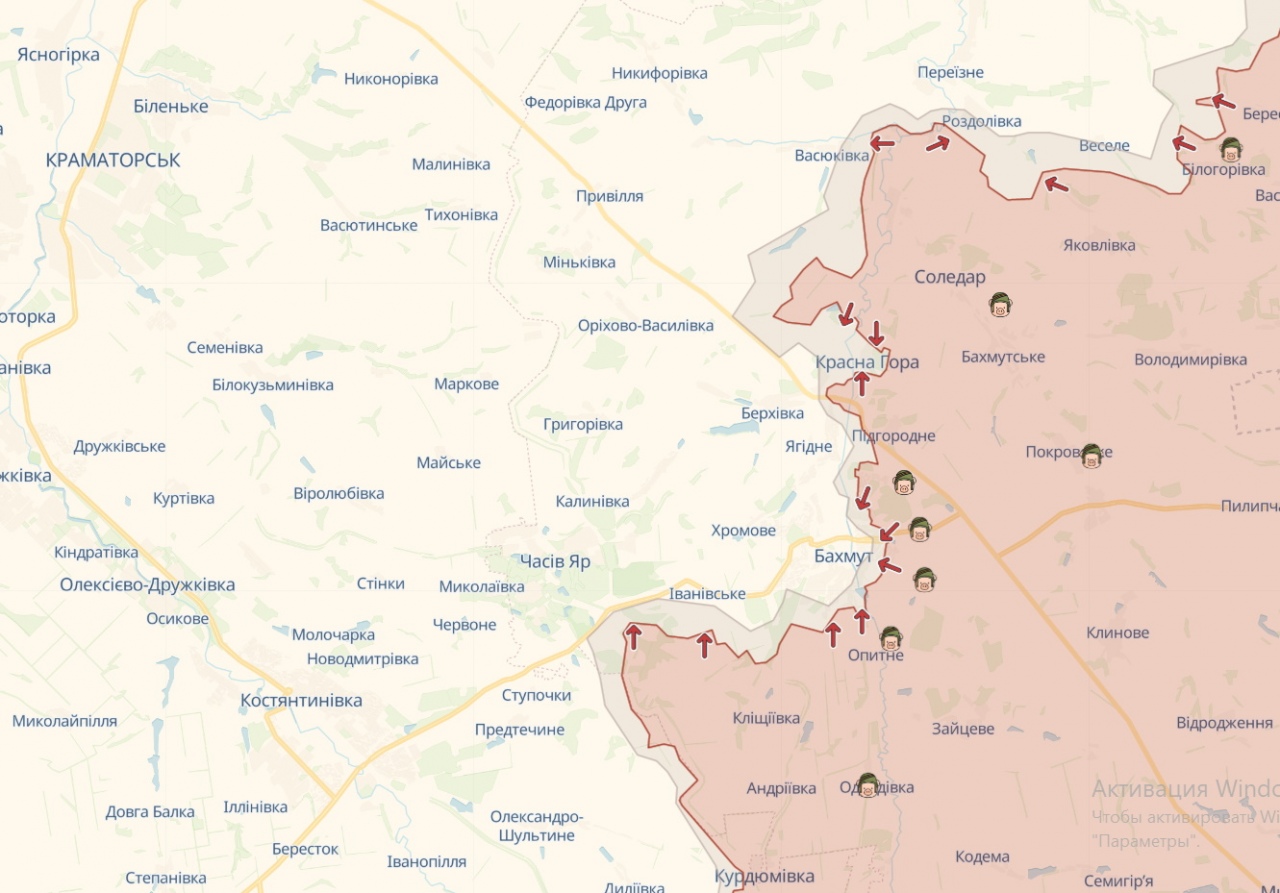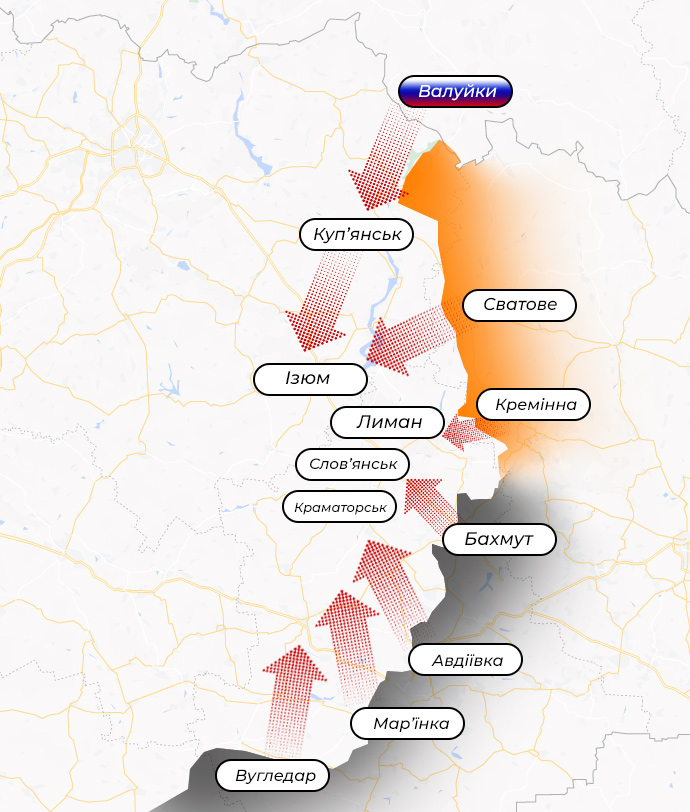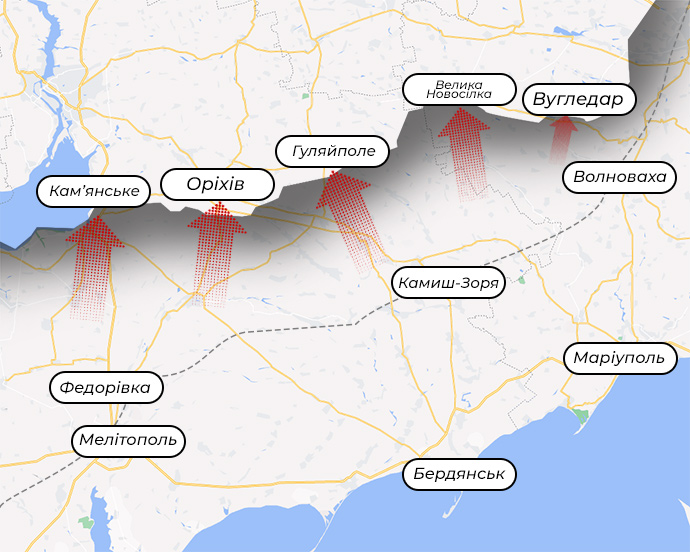Russia's February offensive. Hottest spots on the front now and possible directions of Russia's new attack on Ukraine

On 6 February, an anonymous adviser to the Ukrainian military told the Financial Times that Russia would launch a new major attack on Ukraine within the next 10 days.
This estimate corresponds to the statements made by Oleksii Reznikov, Ukraine’s Defence Minister, and Oleksii Danilov, Secretary of Ukraine’s National Security Council.
Both, however, predict that Russia is more likely to launch their offensive around the one-year anniversary of its full-scale invasion in Ukraine on 24 February.
Major new attacks in eastern and southern Ukraine appear to be the most likely scenario of Russia’s offensive, or at least the most widely discussed one. This was the scenario that Reznikov himself outlined in his recent interview with Ukrainska Pravda.
The Russian government has said, on many occasions, that capturing all of Donetsk and Luhansk oblasts is its top priority. Andrii Yusov, a representative of Ukraine’s Defence Intelligence, has similarly said that Russia intends to establish control over the region.
Yusov said that Vladimir Putin ordered Valery Gerasimov, the newly-appointed commander of Russian occupation forces in Ukraine, to capture Donbas by March.
A "major" offensive would typically entail extensive missile and rocket strikes early on to prepare the ground, followed by airstrikes and a rapid advance of tanks and armoured vehicles, among other things. And though Russia’s current activity in Donbas has escalated in a more gradual manner, it can be said to have reached the scale of a major attack.
Below, Ukrainska Pravda discusses the hottest spots on Ukraine’s fronts, where Russia’s attacks are the most acutely felt now, and the possible scenarios for Russia’s further offensive operations – both those that appear imminently plausible, and those that perhaps seem more tentative.
Bakhmut
Russian forces have been intensifying attacks on the Bakhmut front for the past several months and have made some limited gains in the area. Having captured Soledar, though not without significant losses, the Russians ramped up their attacks on Bakhmut from the south and the north.
Oleksandr Syrskyi, the commander of Ukraine’s Land Forces who oversees the defence of Bakhmut, said that the Ukrainian Armed Forces have been preparing to defend the Bakhmut district and the city of Bakhmut ahead of time, with careful consideration for the peculiarities of the terrain there. The city is surrounded by high points and hills. Sophisticated defence barriers have also helped make the area difficult to capture for the Russian forces.
Bloody battles for Bakhmut have lasted for several months, causing some concern among the Western intelligence community. CNN has reported that the US and other Western officials have urged Ukraine to shift its focus from the battle for Bakhmut to the south of the country, but President Volodymyr Zelenskyy has insisted that Ukrainian Armed Forces will not surrender the city and will continue defending it for as long as they can. It is worth noting that preserving the lives of Ukrainian soldiers is more important than limited, localised success; a hypothetical withdrawal from Bakhmut should not therefore be interpreted as a disaster.
The Institute for the Study of War (ISW) supports this view. Its analysts believe that the defence of Bakhmut is a "strategically sound" operation. According to the ISW, Ukraine would have paid a significant price for allowing Russian troops to take Bakhmut easily.
The ISW also insists that Ukrainian forces have used a similar tactic in other areas, for example in Sievierodonetsk, gradually exhausting and depleting the Russian forces there. Though Russia was eventually able to capture the nearby city of Lysychansk, it has expended a significant amount of effort and resources to achieve this. This prevented Russian forces from quickly expanding the scale of the attack and creating a wider offensive front.

Kramatorsk – Sloviansk
Considering its geographic and military significance, Bakhmut appears to have more of a symbolic importance: the city does not offer a decisive strategic or operational advantage.
From a tactical perspective, the fighting in Bakhmut is preventing Russian forces from expanding their offensive operations in Donbas and launching an attack on the Kramatorsk metropolitan area, which includes Kramatorsk, Sloviansk, Kostiantynivka, Druzhkivka and Lyman.
But capturing Bakhmut will not in and of itself guarantee a successful Russian offensive on Sloviansk, a city which holds a special symbolic significance for Russia.
A full-scale Russian offensive on Sloviansk would have to entail not just a frontal attack from the east (which they have attempted several times), but also a simultaneous attack on the Sloviansk – Kramatorsk axis from the south and the north.
The cities of Izium and Lyman are strategically important for an attack from the north in this area.
These settlements have once been under the occupation of Russian troops, however the Ukrainian Armed Forces managed to liberate them following a lightning-fast counteroffensive in Kharkiv Oblast. Therefore, the Russian army will have to attack these settlements again, in order to accomplish Putin’s dreams.
The Russian Federation realises that without control of Izium, it would be extremely difficult to capture Sloviansk. In this regard, Russian forces are trying to reclaim the initiative east of the city along the Kreminna-Svatove line, where Ukrainian troops are conducting offensive operations as well.
This area of the frontline is strategically important for Ukraine as well, as the liberation of Kreminna opens the way for the Ukrainian troops to reach Rubizhne, Luhansk Oblast. And in the long run, to Starobilsk, which is one of the key logistics centres of the Russian occupiers in Luhansk Oblast.
Therefore, attempts at crossfire attacks are expected throughout the area, including on the Kupiansk front, which is located northwest of the contact line and is an important logistics hub.
Russia has amassed significant forces, including elite airborne units, near the Kreminna-Svatove area in Luhansk Oblast and in the border town of Valuyki in Belgorod Oblast of Russia. They are currently trying to assault Ukrainian positions near Kreminna and would not mind expanding the offensive line.

Avdiivka – Marinka – Vuhledar
Securing support for the attack from the south of Donbas is equally important for the Russian troops.
Russian forces are not letting up their pressure on the Avdiivka and Marinka fronts, where fierce fighting is ongoing.
The city of Vuhledar is currently the hottest area in the south of Donetsk Oblast.
Russian troops have been systematically attacking the city, in particular through the forces of the 40th and 155th Marine Brigades of Russia. However, the 72nd and 79th Brigades of the Armed Forces of Ukraine are successfully "grinding down" the superior hostile forces, skilfully using the terrain, as the city is located at an altitude.
Reports from Ukraine’s General Staff indicate that Russia is losing about 1,000 soldiers and several dozen pieces of armoured vehicles in Ukraine every day. These losses are currently occurring mainly due to the actions of Ukrainian defenders in the area of Vuhledar and on the Bakhmut front.
Vuhledar is important for Russia not only as a gateway for a further offensive into the north of Donetsk Oblast. It is crucial for Russia to drive Ukrainian forces out of the city in order to push back the front line and block the Ukrainian artillery from reaching the railroad line that runs through the settlements of Volnovakha, Komysh-Zoria and Fedorivka.
Taking into account the challenges with the supply of Russian troops along the Donbas-Crimea line after the epic explosion on the Crimean Bridge, the revival of this railroad connection, which is currently, in fact, non-functional, is extremely important for the logistics of the occupying forces in Ukraine’s south.
Zaporizhzhia front
In order to achieve the unimpeded functioning of this railroad line connecting Donbas and Crimea, it is also crucial for Russia to force the Ukrainian troops out of their positions in Zaporizhzhia Oblast. Intensification on the Zaporizhzhia front is expected because of this.
Moreover, Russian forces need to push back the front line, as the Berdiansk-Melitopol land corridor is under threat from long-range multiple rocket launchers, including HIMARS. These cities are currently key logistical points for transit between Donbas and Crimea.
Both parties call Melitopol "the key to Crimea."
The city is important for Ukraine because it will enable the southern grouping of the Russian army to be cut off as much as possible and will put the Crimean Isthmus under threat of fire. Russian forces anticipate a Ukrainian counteroffensive in this area and are seeking to protect the city from possible attacks.
Russian troops have been conducting major combat operations on the Zaporizhzhia front near the settlements of Velyka Novosilka Huliaipole, Orikhove and Kamianske in recent weeks.
So far, the Russian activity looks more like a probing of weaknesses in the Ukrainian defence. However, the concentration of significant Russian forces in the area near Mariupol, as reported by Ukrainian intelligence, does not exclude the possibility of an attempted breakthrough on this front.
In addition to pushing the front line away from logistics roads, Russian forces may try to enter the Joint Forces Operation's [set of military and special organisational and legal measures of the Ukrainian security forces on the territory of Donetsk and Luhansk Oblast aimed at countering Russian-backed separatists – ed.] rear at the junction of Zaporizhzhia and Donetsk oblasts and cut off supplies to the Ukrainian army in Donbas. However, considering their recent minor gains, this seems unlikely at this point.

Kherson and Odesa
When one speaks of Ukraine’s south, Russian imperialists’ dreams of Odesa and "getting back"' Kherson are always mentioned as well.
These fronts of the Russians’ offensive seem to be entirely theoretical at the moment. Landing of paratroopers on the coast of Odesa Oblast was not successful even during the first stage of the invasion when the Ukrainian Armed Forces looked very lost in the south. And even more so after losing the Moskva and leaving the Zmiinyi (Snake) Island.
The situation is more complicated with Kherson. However, it is like that more because of constant attacks on the city that the Russians are terrorising Kherson residents with, and not because there are chances of the second capture.
The Armed Forces of Ukraine have damaged the logistics of the Russian grouping on the right (west) bank of the Dnipro river with long-range artillery (hello, HIMARS!) which led to the occupiers leaving Kherson.
Therefore, going there again, presumably making the same mistake with the logistics, just does not have any sense. Not to mention the necessity of forcing the Dnipro river that seems to be a challenging task after destroying big bridge crossings.
Belarus, Kyiv, Kharkiv and Sivershchyna
The second offensive from Belarus has been one of the main topics for discussions this whole summer and autumn. Joint military exercises of the Russian and Belarusian armies and permanent bipolar statements of the self-proclaimed president Alexander Lukashenko have fueled these conversations.
Currently, no clusters of military manpower and equipment, enough for a large-scale offensive, are detected in Belarus. It can be only about some spot intimidation, bragging with weapons at the border and imitating a big offensive in order to distract the Ukrainian forces from other fronts.
Ukrainska Pravda has recently described possible scenarios of an offensive from Belarus in detail, so we will not stop there now. If you want to remind yourself of these options, feel free to read more about it in the mentioned article.
The second attack at Kyiv has been highlighted separately in this article, as Valerii Zaluzhnyi, Commander-in-Chief of the Armed Forces of Ukraine, warned about it earlier without giving any precise time frame.
If we take an attempt to capture Kyiv without using the territory of Belarus, this task is hypothetically possible, even though it is much more difficult.
At the moment, Oleksii Reznikov, Minister of Defence of Ukraine, also believes that possibilities of the offensive at Kyiv are questionable. Analysts of the ISW agree with him, they assess chances of the Russians capturing the capital of Ukraine as extremely unlikely.
The Russians have concentrated their significant forces in Bryansk, Kursk and Belgorod oblasts of Russia now. This can allow them to carry out an offensive in Sumy Oblast or Kharkiv Oblast with the further possibility to go at the capital or the second attack at Kharkiv, or the assault on the Kupiansk front that was mentioned earlier.
These actions can be large or local in order to take over the initiative in the war, which was pointed out by Oleksii Danilov, Secretary of the National Security and Defence Council of Ukraine, in the interview with Reuters.
A large offensive at big cities or even larger forced march over Sumy and Poltava oblasts towards the Dnipro River requires certain preparations at the Russia-Ukraine border that is not detected at the moment.
Some logistics have to be deployed in order to perform such scenarios (fuel, field support of the army, etc.) and manpower. None of these conditions are fulfilled yet.
In general, as experts say, about 250-320,000 Russian soldiers are currently involved in the war in Ukraine, 150-200,000 more are in reserve.
Even though these numbers are higher than in February 2022, they do not seem to be enough. However, it does not rule out that Moscow is capable of forming attack groupings on several fronts and trying to cause significant damage to the Armed Forces of Ukraine even before spring washes off all roads or new Western equipment that the Kremlin does not really want to encounter arrives.
***
Last assessments of military experts and intelligence data advise Ukrainians to focus mainly on the east and the south. However, it is best not to forget that the goal of any party of the war is to surprise the opponent as much as possible.
It is hard to imagine at this stage that Russia can carry out some large hidden manoeuvre that will catch the Armed Forces of Ukraine off guard. The Ukrainian soldiers are very much focused, so the surprise effect, such as the one in February 2022, will most probably not be successful.
The enemy and its desire to win should not be underestimated, though. Even more so, when it is about the bloody dictator who is ready to pay any price for his goal. Even if it means to sacrifice millions of his own soldiers.
The main task for Ukraine at this stage of the war is to withhold the spring escalation with as little losses as possible. We need to save resources until multi-purpose equipment from Western partners comes in order to launch a full counteroffensive at the end of spring or in summer.
Yevhen Buderatskyi, UP
Translation: Olya Loza, Artem Yakymyshyn and Myroslava Zavadska
Editing: Dasha Narog
Journalists fight on their own frontline. Support Ukrainska Pravda or become our patron!